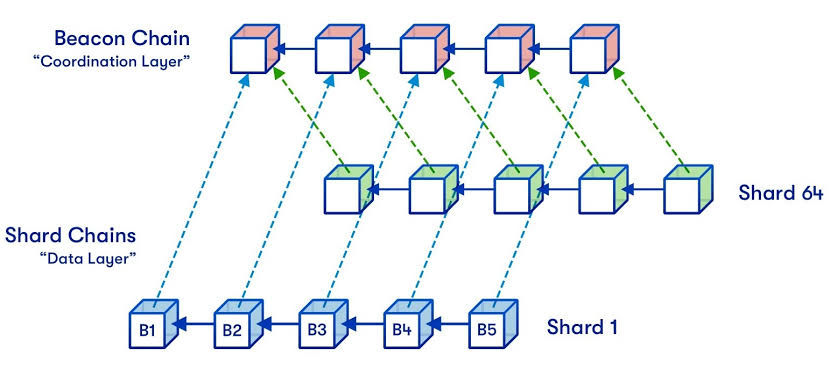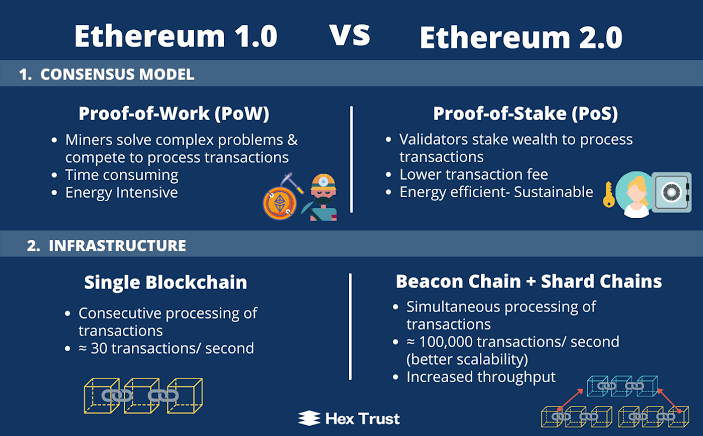Blockchain developers keep upgrading the Ethereum network to improve users’ experience. Among several other ongoing upgrades, Ethereum sharding is effective in proffering a solution to users’ long-time complaint – high gas fees.
Ethereum Sharding is a process that involves segregating the network into several parts, with each having its functions and smart contracts. This means that every part of the Ethereum network, known as shards, will function independently.
How does Ethereum sharding works? Find out more as you read further, including how sharding will impact the future of Ethereum and encourage more users to get on board.
Overview of the Ethereum Upgrade Framework

Previously, Ethereum used the Proof of Work mechanism to process nodes’ activities on its network, which is not as efficient as required. As a result, the Ethereum team developed a framework that involves a continuous and long-term upgrade process, including Beacon Chain, the Merge, and Shard Chain. During the Merge phase, Ethereum successfully transitioned from Proof of Work to Proof of Stake in September 2022 – this was a significant change within the Ethereum ecosystem. However, experts believe there won’t be a significant decrease in Ethereum’s gas fee until it reaches the sharding phase.
Shardeum is a significant part of the Ethereum upgrade, which includes several elements. These elements are; sharding, linear scaling, atomic processing, and dynamic state sharding. Shardeum has been hosting notable applications since 2017, which includes Spriyo NFT, Swapped Finance, and Bandit Network. With the sharding mainnet in view, it will scale Shardeum, making it accommodating for more applications or use cases.
What is Sharding?
Sharding is a technique employed to simplify a database’s processing time by distributing data across several machines or computers. The distributions are usually in parallel, fueling applications’ scalability. It also helps to reduce the congestion rate in databases with an overwhelming number of users.
Recently we increased the gas limit of the Ethereum blockchain from 8 million gas per block to 10 million gas per block, a 25 percent capacity increase. Guess what happened? Before the capacity increase, the blockchain was about a hundred percent full. After the capacity increase, the blockchain was a hundred percent full. There’s a lot of people who love Ethereum and want to be part of it, but who are just waiting for scalability technology to let them.
In Ethereum, sharding will break down large blockchains into nodes with similar functions. Also, each node is designed only to carry out operations pertaining to it, which further improves the blockchain’s security level. With pruning and sharding mechanisms, developers can reduce storage requirements and transaction speed on the Ethereum network.
How Ethereum Sharding Works

Since Ethereum nodes are now in segments, every transaction will be processed in chains, linking up to 64 databases, each containing about 128 validators. These validators will then be responsible for confirming transactions at 12 seconds intervals.
How Sharding Will Reduce Gas Fee
As mentioned earlier, crypto enthusiasts believe Ethereum’s high gas fee problem will be solved at the sharding phase. You may wonder, how is this going to happen?
Every scaling solution on the Ethereum network can either be on-chain or off-chain. On-chain scaling solutions are usually implemented directly on the Ethereum blockchain. On the other hand, off-chain solutions are usually an external input, or another layer built on the Ethereum blockchain, often known as layer-2.
An example of an off-chain scaling solution is a rollup, which provides a short-term effect. However, on-chain scaling solutions, like sharding, will have a long-term effect or result. Interestingly, when sharding and rollup are combined, they will break down the system’s large volumes of transaction data.
Read this article to learn more about the role of on-chain in the world of cryptocurrency.
According to Ethereum developers, they are using shards to confirm transactions and distribute extra data. The team also aims to boost Ethereum’s capacity, up to 100,000 transactions per second (TPS), compared to its current 13 TPS. Since the network’s congestion rate will be minimized, Ethereum’s gas fee will also drastically reduce.
Benefits of Implementing Sharding in the Ethereum Network
According to Etherscan, Ethereum nodes already occupy up to 5 terabytes of space, about ten times its former capacity. As the nodes continually take in more data and the number of users increases, maintainance will require a lot of work. However, sharding can help manage this growth by supporting more data and distributing them appropriately.
This article explains blockchain’s scalability best practices.
Apart from Ethereum shard’s scalability property, the other benefits of implementing sharding in the Ethereum network are below.

It Maintains Decentralization
Sharding helps to maintain decentralization by allowing developers to run nodes without changing the size of their database. Wherein, increasing the size of an existing database promotes centralization because validators will have to keep up with technical requirements. The expensive electricity bills, cooling system, and other requirements will create an entry barrier, thus forming a centralized system.
Sharding further improves nodes’ flexibility, as validators wouldn’t need to own expensive and powerful computers before running nodes. Since users are spending less on system hardware, sharding will help reduce the cost associated with data storage.
Increased Level of Participation
Ethereum sharding aims to increase participation so individuals can run nodes differently on their computers, including mobile phones. This will encourage more people to become active participants on the Ethereum platform. Conversely, the decentralization advantage of Ethereum sharding will boost its security level.
Enhanced Performance and Efficiency
Since Ethereum sharding involves multiple chains, the transaction process can be faster, making Ethereum a close competition to payment systems like PayPal regarding processing time. Meanwhile, Ethereum developers are also working towards improving sharding efficiency via the dank sharding (EIP-4844) approach. Instead of shard chains, shard blobs will be used for splitting data.
🌟 What are the benefits of EIP 4844?
EIP-4488 is taking the first step forward toward Sharding.
This will initially help layer 2 rollup solutions the most and eventually help Ethereum reduce its gas fees and onboard the next million users. pic.twitter.com/DMcNAB0Eko
— Abubakkar (@Abu__Crypto) July 23, 2023The Ethereum team has promised its community to expect more development in the future, which would improve the overall efficiency rate.
Is Ethereum Sharding Secure?
The security threat is one of the biggest concerns in the Ethereum blockchain upgrade. Some crypto analysts are worried that an attack from a bad actor or validator will affect the whole network since Ethereum exists in shards. However, measures will be implemented to curb potential attacks, such as random sampling of validators. Also, the emergence of Ethereum protocols like EigenLayer, makes the network more secured than ever.
You can read this article for more information about EigenLayer.
When Will Ethereum Sharding Take Place?
Implementing sharding into the Ethereum blockchain requires patience, as developers need to ensure one node piece can collect the right data from other nodes. However, Ethereum sharding has been part of the Ethereum 2.0 framework for a long time. The team announced in February 2023 that the community should expect a prototype of danksharding before the year ends. During the announcement, it was also emphasized that the project had attracted over 50,000 contributors.
Conclusion
Everything we know about Ethereum sharding is on paper and has yet to be implemented. Although Ethereum sharding is a great concept, its effect has yet to be fully known. However, Ethereum developers have established the importance of Ethereum sharding in ensuring scalability and reduction in gas fees. Since Ethereum now uses Proof of Stake, it will also be easier to implement sharding on it than the former Proof of Work mechanism.




















